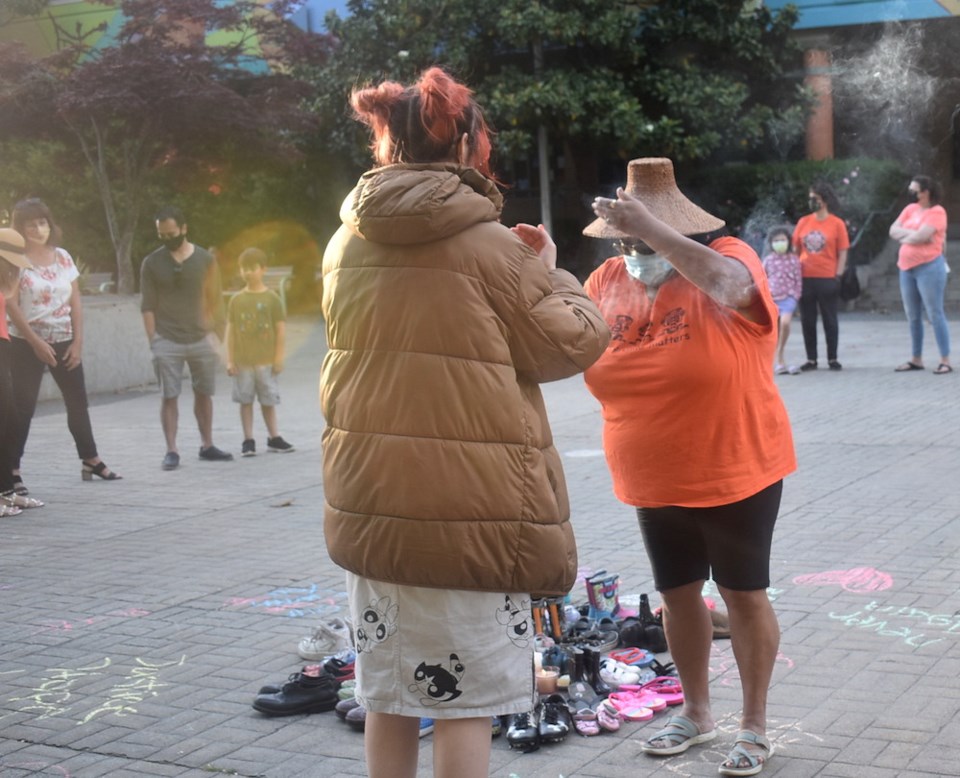An hour-long vigil at the Richmond Library and Cultural Centre Monday evening honoured the memory of 215 Indigenous children on the grounds of the Kamloops Indian Residential School whose remains were revealed to the public last week.
Renée Robinson, a Richmond resident whose parents and other family members went through the residential school system, said the mass grave at the residential school has made Canadians finally listen.
“I’ve been talking about a genocide for about 30 years now,” Robinson said. “It seems finally that Canada has agreed and sees what we’ve been talking about.”
Robinson said the vigil and messages on social media show people are starting to understand how Indigenous people were treated through the residential school system and other forms of racism.
“It lightens the load for us,” Robinson said. “There’s a lot of emotional labour talking about it constantly.”
Robinson belongs to the Tsartlip First Nation — located just outside Saanich — but she grew up in Merritt and the Shuswap.
Her parents attended St. Eugene’s residential school in Cranbrook.
Robinson recounted how her father was pushed down the stairs as a teen at the residential school and broke his leg and hip but didn’t receive any medical attention until he collapsed two weeks later.
When a doctor was finally called, her father was septic and was taken to the hospital where the bones had to be rebroken and reset as they had started healing.
Despite two dozen surgeries, he was in pain all his life and became addicted to opiates prescribed for pain control.
“So, he was a non-functioning member of this Canadian society and people see that and they say the stereotypes — they say we’re drunks, they say we’re addicts ... but they don’t see what has happened to (us),” Robinson said.
As an Indigenous awareness coordinator, Robinson said seeing how Canadians are reacting to the news of the children’s bodies found on the grounds of the former residential school in Kamloops is a “huge step” and it feels like they are starting to begin reconciliation.
But, she added, it can’t be a “single act.”
“It has to be an understanding and it seems like this week, somehow, the bodies in Kamloops, it’s really touched people so deeply that they’ve reacted,” Robinson said.
The memorial event was organized Monday by Karina Reid, who has been calling on the City of Richmond to cite a land acknowledgment before public meetings.
Reid told the Richmond News she wanted to create a space where Canadians could show they’re “grieving in solidarity as a nation.”
“This is a huge atrocity for all Indigenous people — it’s so triggering and a painful reminder of the colonial country we live in,” Reid said.
“My settler responsibility is to make sure we do everything we can to decolonize every day,” she added.
About 150,000 Indigenous children across Canada were taken away from their families and forced to attend residential schools, run by churches, from the late 1800s to the 1970s. Many suffered physical, mental and sexual abuse and were banned from speaking their native languages.
Richmond South Centre MLA Henry Yao, who also attended the vigil, said it would be “overly arrogant” of the provincial government to say they know how to help residential school survivors and their families; rather, the government can allow Indigenous people to “enlighten us how we can support them.”
“The most important thing… is to start reaching out and asking them. Because they are the people who walked through the pain, walked through the suffering — they know their own emotional wounds.”
Yao said the recent anti-Asian racist incidents are “almost nothing” compared to the stories from residential schools.
“The darkness of racism, how deep, how much pain (it) can bring to a family, a community, a culture — it’s incredibly destructive,” Yao said.
Both the City of Richmond and the Richmond School District have lowered their flags to half-mast in honour of the 215 children found in Kamloops.
Sandra Nixon, chair of the board of education, said teaching all students about the history of colonialism and the legacy of residential schools is a priority for the school district.
“Real change moving forward really starts with attitudes and the education of this generation,” she said.
Nixon said teaching all students about the history of colonialism and the legacy of residential schools is a priority for the school district.
“Real change moving forward really starts with attitudes and the education of this generation,” she said.
Nixon grew up in Manitoba in the 1980s surrounded by First Nations reservations where there were a lot of racist attitudes, which is why it’s important to teach children about reconciliation, so that these attitudes don’t become engrained in their minds, she added.
Reid said it was “heartbreaking” to see the dozens of children’s shoes in the library plaza representing the death of a child as young as three found in the grave in Kamloops.
There were about three dozen shoes on Monday and that number increased to more than 100 as of Thursday.
Reid is calling on the community to bring more shoes so that there are 215 pairs and that the memorial stay for 215 hours, until Tuesday at which time there will be another vigil at 7 p.m.



